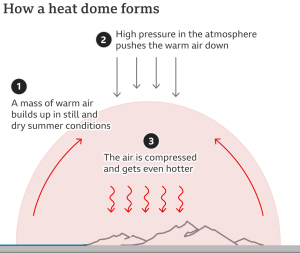Heat Dome
About
- A heat dome is a weather phenomenon where a high-pressure system in the atmosphere traps warm air like a lid on a pot, for an extended period of time.
- The system traps hot air and prevents it from flowing to rise and cool. This air then becomes compressed and heats up, leading to a dome-shaped area of hot air that can persist for several days or even weeks.
- As the warm air is not able to rise upward, the sky remains clear (as clouds are formed when the rising warm air cools down, and the water in it condenses out).
- The high-pressure system allows more sunlight to reach the earth, which results in more warming and drying of soil. This leads to less evaporation and reduces the likelihood of the formation of rain clouds.
- The longer the heat dome stays in one place, the warmer conditions can get with every passing day.

Causes of Heat Domes
- Role of the jet stream:
-
- A heat dome’s formation is tied to the behaviour of the jet stream.
Jet Stream
|
- Typically, the jet stream has a wave-like pattern that keeps moving from north to south and then north again.
- When these waves get bigger and elongated, they move slowly and sometimes can become stationary. This is when a high-pressure system gets stuck in place, and leads to the occurrence of a heat dome.
- Climate Change:
- Climate change has also been identified among the contributing factors to the increased frequency and intensity of heat domes.
-
- Climate change has led to warmer background temperatures, exacerbating the high-pressure system. Regions that have become drier due to the same, can also create conditions that are beneficial to the formation of heat domes.
- Intensity and duration of a heat dome can also be influenced by other factors, such as the amount of moisture in the air and the presence of other weather systems.
Impacts of Heat Dome
- On Environment: Heat domes may cause droughts and wildfires due to the hot and dry conditions, paired up with reduced rainfall.
- On Human Health:
- Heat exhaustion occurs upon exposure to high temperature for extended periods of time, and can be characterised by symptoms such as dehydration, dizziness and nausea. In more severe cases, heat exhaustion can progress to a heat stroke, a medical emergency that can cause organ damage and even death.
- Hot weather can also put stress on the heart and lungs, particularly for those with pre-existing conditions like asthma or heart disease.
- Construction workers, farmers and agricultural workers, who work outdoors for long hours, are at increased risk of heat-related illnesses due to their prolonged exposure to high temperatures.
- Heat domes also cause damage to infrastructure such as roads and buildings, particularly if they were not designed to withstand such conditions.
How to combat heat domes?
Heat domes are a natural weather phenomenon and hence, stopping heat domes from forming altogether is not possible. However, there are steps that can be taken to mitigate their impacts and reduce the likelihood of them occurring as frequently or with as much severity. Some strategies are:
- Reducing greenhouse emissions: Transitioning to renewable energy sources, improving energy efficiency and promoting sustainable transportation is critical to mitigating the impacts of heat domes in long terms.
- Investing in green infrastructure: Cities can invest in green infrastructure, such as parks, green roofs, and tree planting, which can help reduce the urban heat island effect and provide cooling benefits.
- Implementing building codes and standards: Building codes and standards can help ensure that new buildings are designed to withstand extreme heat and maintain indoor comfort during heat waves.
- Reducing heat-trapping surfaces: Cities can take steps to reduce the amount of heat-trapping surfaces, such as asphalt and concrete.
- Enhancing public education and outreach: Educating the public about the risks of extreme heat and how to stay safe help reduce the incidence of heat-related illness and mortality.
Subscribe
Login
0 Comments
